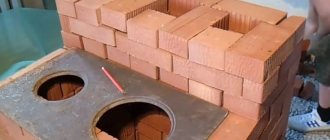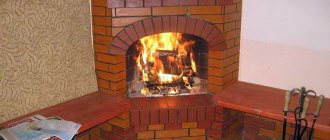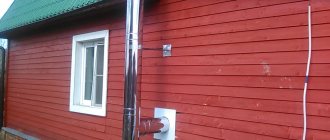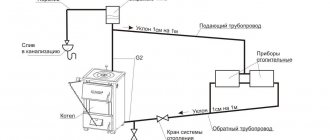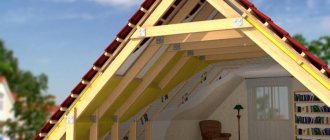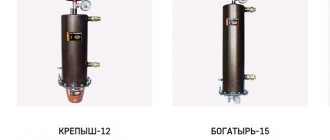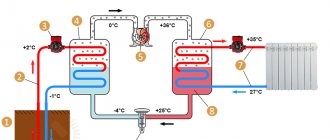Natural fuel reserves are not unlimited, and energy prices are constantly rising. Agree, it would be nice to use alternative energy sources instead of traditional ones, so as not to depend on gas and electricity suppliers in your region. But you don't know where to start?
We will help you understand the main sources of renewable energy - in this material we looked at the best eco-technologies. Alternative energy can replace conventional power sources: you can create a very effective installation for producing it with your own hands.
Our article discusses simple methods of assembling a heat pump, wind generator and solar panels, and selects photo illustrations of individual stages of the process. For clarity, the material is provided with videos on the production of environmentally friendly installations.
For home
The owner of a country house, even if there is a traditional power supply system, sometimes has a desire to reduce the cost of paying bills for consumed electrical energy. Some developers create a completely autonomous system and become independent from electricity suppliers. This power supply system is especially relevant for remote places where there are no stationary power supply networks. Currently, thanks to the development of technology and technology, installations using alternative energy sources, such as solar, wind, water and biofuels, have become widespread. When producing your own electricity, used to power your home, all of the above energy sources can be used.
Energy of sun
When choosing installations that use solar energy as a source of electrical energy, you need to know the features of the location, which determine the number of sunny days per year.
Modern Stirling Engine - Can also be seen as a way to get your own electricity - system efficiency up to 34%!
Devices used to convert solar energy into electrical energy are solar panels (batteries), which, depending on the required power, are combined into groups. The panels consist of photocells placed in a common housing. The principle of operation is based on the properties of photocells to create a potential difference between their layers when exposed to sunlight.
Solar panels are the main element of solar power plants, which, in addition to them, include the following elements:
- A rechargeable battery (battery pack) is a storage device for electrical energy.
- The controller is an electronic device responsible for the charging and discharging process of the battery.
- An inverter is also an electronic device that converts direct electric current accumulated in a battery into alternating current with a voltage of 220 V.
- Protection devices and automation devices, as well as connecting wires.
As additional equipment to increase the efficiency of solar power plants, solar trackers are used - devices that allow you to determine the position of the panels in space, in accordance with the location of the sun.
Wind energy
When choosing an alternative energy source, which will be wind, it is also necessary to know what winds and what strength are blowing at the location where the equipment is installed. Devices that convert wind energy into electrical energy are wind generators. These technical devices differ in power, performance, installation conditions and design, on which all the previously listed indicators depend.
Wind generators are:
- With a horizontal axis of rotation - the rotor axis and the drive axis are parallel to the surface of the earth. There are single-bladed, two-bladed, three-bladed and multi-bladed, with the number of blades up to 50 pieces.
- With a vertical axis of rotation - the axis of rotation is located vertically relative to the surface of the earth. These devices differ in technical design: with a Savounis rotor, with a Darrieus rotor, with a helicoidal rotor, with a multi-blade rotor and with an orthogonal rotor.
- Wind generator - sail.
All of the listed devices have their own advantages and disadvantages, so the choice is always up to the user, which can be made based on selection criteria and individual needs.
Water energy
Living outside the city and having a small river, stream or other body of water nearby, you can use the energy of water to generate your own electricity. In this case, it is necessary to build an individual micro-hydroelectric power station. Equipment for such installations is produced in various capacities, and even a small stream can meet the electrical energy needs of a home.
Micro-hydroelectric power plants are bottled in:
- Type: dam, diversion, dam-diversion and free-flow.
- Operating principle: "water wheel" principle, garland design, using Darrieus rotor and using the propeller principle.
- Installation capacity and equipment installation conditions.
Each type of micro-hydroelectric power station and the principle of its operation have their own pros and cons, which determine the choice of equipment and the possibility of use in a particular case.
Biofuel
Living side by side with wildlife, there is always the opportunity to construct a biofuel production plant. Biofuels come in solid, liquid and gaseous forms.
It is not advisable to consider solid fuel (ordinary firewood) and liquid fuel, which requires special equipment for production, as sources of electrical energy, but gaseous fuel can.
Gaseous biofuel is biogas obtained as a result of fermentation of substances of plant or animal origin, which are always available in the household. The fermentation process occurs under the influence of bacteria in a hermetically sealed container. The gas thus obtained is sent for combustion. When gas is burned, the steam generator produces enough steam to rotate a steam turbine connected to an electrical generator that produces electric current.
Earth energy
On the territory of our country, there are places where activity continues in the deep layers of our planet (in the surface of the earth). In such regions, earth energy can be used as an alternative source of electrical energy.
Depending on the source that gives off its heat, such energy is divided into:
- Petrothermal - the source of energy is layers of the earth that have a high temperature;
- Hydrothermal - the source of energy is groundwater.
The earth's energy, in the form of steam, is supplied to a steam turbine, which is connected to an electrical generator that produces electric current.
In the case of individual use, only the method of using direct action is possible, when steam comes directly from the surface of the earth.
Other options, indirect and mixed methods, can only be used in industrial methods of energy processing.
All the options discussed above for using alternative energy sources to produce their own electricity are available to users, provided that the necessary conditions for their operation are created.
To create independent power supply systems, it is better to use several alternative energy sources simultaneously to compensate for the possible difficulties of each method of generating electricity separately.
Quite widely, for autonomous power supply to houses, the wind generator + solar power plant scheme is used.
Heat pump manufacturing
Heat pumps provide heating and hot water using soil, water and even air.
Operating principle and typology
Pumps require electricity, so they must be used in combination with another source of energy. They work on substances like freon. Their specificity is that they boil only at low temperatures. In a gaseous state, the substance begins to produce heat. The installation consists of three parts: internal circuit, external circuit and pump circuit.
The external one is usually buried in the ground or lowered to the bottom of the reservoir. Under the influence of external factors, the circulating freon begins to heat up. The high pressure of the external circuit pump turns it into a gaseous state. As a result, the temperature reaches 70C°.
A diagram that clearly explains the principle of operation of a heat pump.
The internal one acts as a distributor; it distributes the heat heated in the pump throughout the entire area. The collector can be installed in any convenient position, both horizontally and vertically (sometimes the size of the site does not allow installation horizontally).
The pump circuit is lowered into the wells to a depth of 1-1.5 meters, having previously been drilled. If the house is located near a lake, then the heat exchanger is laid in the water. An air conditioning compressor is ideal. The 120 l tank will be the condenser. A copper coil is installed in the tank; it is needed so that freon circulates through it. It is important that the walls of the coil are at least 1 mm thick. If you ignore this parameter, the pipe may undergo deformation during winding.
Thanks to this design, the water begins to warm up. A plastic barrel with a volume of 130-140 liters is suitable for the evaporator. Another coil is mounted into it, and a compressor will connect the first and second tanks.
The PVC pipe will serve as the evaporator pipe. It performs the function of regulating the fluid. The evaporator is immersed in a body of water. Water immediately begins to flow around it and a reaction occurs - evaporation of freon. The condenser produces gas and supplies heat to the water containing the coil. The room begins to warm up due to the circulation of the coolant.
It is important to know
To achieve maximum efficiency from the device you use, keep these simple rules in mind:
- Do not pay attention to the temperature of the water at the source, the main thing is its stable presence.
- Accurate thermodynamic calculations guarantee that the system will work productively
- Correct design and proper installation of the pump will eliminate many problems and ensure its stable operation.
- Power is the most important indicator of a heating design. Based on this, the more expensive the components of the heating system, the higher the power.
Types of heat pumps.
The ideal condition is any body of water located on the site. The pump option using water will significantly reduce work on the ground. Operating a pump using the heat of the earth, on the contrary, involves a lot of excavation work.
The economics of obtaining such energy
The main difference between a heat pump and other generators is that up to 70% of the energy is extracted from the environment. This type of energy production is considered environmentally friendly. Now let's look at the issue of efficiency; the calculations are very easy to do. First, let's calculate the price for 1 kW of heat in a certain region.
Here are the data for calculation:
- Dry logs - 4,000 kW/kg.
- Wet logs - 3,100 kW/kg.
- Anthracite - 5,900 kW/kg.
- Coal - 3,050 kW/kg.
- Fuel - 11,900 kW/kg.
- Fuel oil - 11,000 kW/kg.
- Gas (natural) - 11,000 kW/m3.
- Gas (liquefied) - 22,800 kW/m3.
Actually, after calculations, it is necessary to make a significant decision on the operation of one or another heat source.
For apartment
If there is a desire to create an independent power supply system for a single apartment, in an apartment building, it is impossible to use such sources as: biofuel, earth energy, water energy, and wind energy, it is also difficult to use.
The only source of energy that can be used to generate your own electricity in a separate apartment, without creating inconvenience for neighbors, is the use of solar energy.
The industry produces sets of solar power plants of low power, which can easily be placed in an apartment. Solar panels, in this case, are placed on the roof of an apartment building or on the external facade, if it is located on the south side of the house.
A solar power plant kit, not very powerful, consists of the same elements as for powering a house, the only difference is in the number of solar panels and batteries.
Where and in what form to get energy resources
Use of solar panels
Traditional energy sources are thermal, nuclear and hydroelectric stations. Alternative energy supplies are self-renewing, efficient, cheap and environmentally friendly. In fact, energy is in natural resources, you just need to try to extract it. Without special skills, you can perform the following work:
- install solar collectors and batteries to power lighting or heat water;
- install wind generators;
- use heat pumps to heat a house using heat from water, earth or air;
- use biogas plants for processing animal, bird, and human waste.
The disadvantage of non-traditional energy sources is the large financial investments for their organization.
Options for a summer residence
If it is necessary to create an independent power supply for a dacha, the option of using a solar power plant is also the most acceptable. In this case, if the equipment is used seasonally, it is possible to mothball the devices or take them out of operation for the period when there is no need for operation.
The option of building a wind generator is also quite affordable and justified. Because having incurred some one-time financial expenses, in the future you can, depending on your needs, receive your own electricity.
The option of using the “wind generator + solar power plant” scheme is also relevant in this case, and allows you to create a completely autonomous and reliable power supply scheme.
How to make it yourself
The sets of equipment described above are quite expensive, so creative people with engineering savvy sometimes have thoughts about how to make this or that device with their own hands.
In order to make a unit capable of producing electrical energy using alternative energy sources, it is necessary:
- Have basic knowledge of electrical engineering and electrical networks;
- Possess skills in working with hand mechanical and electrical tools;
- Be able to work with a soldering iron;
- Have free time and, most importantly, the desire to create your own device capable of generating electricity.
If you choose the sun's rays as an energy source, then you need to make a receiving panel - a solar battery. There are several ways you can do this:
- Purchase photocells and connect them in a certain way (done by soldering). Make a panel body in accordance with the dimensions of the assembled receiver, into which to place the photocells. With this manufacturing option, it is possible to produce a fairly efficient device that can provide electrical energy to a small cottage that is not used for a long time.
- When the load power is low, when you need to charge a cell phone or other electronic device, you can make a solar panel from used diodes or transistors.
- When using transistors, the covers of the transistors are cut off and the transistors themselves are connected in series. The transistors are placed in a separate housing, and leads are soldered to their ends. The device operates when sunlight hits the “pn” junction of the transistors.
- When using diodes, you will need a large number of them and an electronic board, which is used as a substrate. The upper part of the diodes is cut off and using a soldering iron, the crystal is removed from the housing. The crystals are soldered sequentially, on a substrate, into separate blocks. The blocks are connected to each other in parallel.
- It is best to purchase batteries and electronic devices (charge controller and inverter), if they need to be installed, although if desired, electronic devices can also be made independently. If you choose wind, water, biofuels and earth energy as an energy source, then the production of technical devices capable of generating their own electricity is also possible.
Solar panels
A solar panel consists of a series of connected elements that convert sunlight into a stream of electrons. A characteristic feature is the fact that they are not able to generate high voltage current. A single cell produces up to 0.55 V of current, and a single cell produces up to 21 V of current, which can power a 12-volt battery.
Naturally, to provide a home with electricity, you will need a system of dozens of such devices. It also includes the following components:
- controller to control battery charging, prevents re-charging;
- an inverter that converts current from low to high voltage;
- battery.
It is better to purchase all three elements ready-made, but you can make a solar battery yourself.
Battery manufacturing process
The battery is assembled from modules consisting of 30, 36 or 72 photocells. They are connected in series with the power supply, its maximum voltage is 50 V.
Stages of work:
- The bottom of the case is cut out of plywood and inserted into a frame, with holes drilled around the perimeter of it. They are necessary to provide ventilation and prevent overheating during operation.
- The substrate for solar cells is cut to the size of the housing; it is also necessary to provide for the presence of holes.
- The case is painted and dried, after which solar cells are laid out upside down and sealed.
- The elements are first connected in rows, then they are connected to the current-carrying busbars.
- The inverted elements are fixed with silicone.
The output voltage should be about 18-20 V, you need to make sure of this first. Also, the functionality of the battery is checked for several days, only after that the joints are sealed and the power supply system is assembled.
When installing the panel, pay attention to the following:
- Do not place the battery in the shade of trees or tall buildings.
- Orient the battery towards the sun.
- Correctly determine the slope.
- Ensure accessibility for timely removal of dust, dirt and layers of snow.
- Provide a stand that adjusts the angle of inclination for the winter and summer seasons.
Wind generator from a room fan
The simplest wind generator can be made from an ordinary household fan. To do this, you will need a small generator from a vehicle or an engine-generator, which must be mounted on a room fan stand. To do this, you can use any plastic container, inside of which the converting device is placed. At the edge of this, a diode bridge is placed in the container, to which wires are connected, which are brought out to the outer surface of the container.
Fan blades are placed on the shaft of the generator (motor-generator), and a shank is attached to a plastic container, which can be made from scrap materials (plastic, plywood, plexiglass, etc.).
The entire assembled structure is placed on the fan stand; for this you can use a piece of plastic or other light pipe with a diameter slightly smaller than the hole in the stand. This will allow the structure to rotate around its axis, depending on the direction of the wind.
The fastening of parts and assemblies is checked, and if necessary, they are strengthened. A load is connected to the output wires. The device is ready for use.
Your own electricity and your own water
Living outside the city, and having a small river or stream near your home or dacha, you can always provide yourself not only with water, but also with your own electricity. Of course, you can purchase a set of micro-hydroelectric power stations, which are quite widely represented on the domestic market, but you can make a similar device with your own hands. The design can be simple or complex, it all depends on the need for electrical energy, as well as on the type of reservoir, i.e. the ability of water to create pressure in a given direction.
To make the simplest design, you will need a car generator, a bicycle or other wheel, a pair of pulleys of different diameters or sprockets, as well as a metal profile (angle), which is available.
The mounting structure for the wheel and generator is made from a metal profile. The wheel can be positioned parallel or perpendicular to the plane of the water, it depends on the type of reservoir. Blades made of metal, plastic, plywood or other material are attached to the wheel. A pulley (sprocket) of larger diameter is attached to the wheel axle.
The generator is mounted, and a pulley (sprocket) of smaller diameter is attached to its shaft. The pulleys are connected by a belt drive, the sprockets by a chain. Wires are connected to the generator terminals. The wheel is placed in water. The installation is ready for use.
Magnetic free energy generator
The effect of interaction between a magnetic field and a coil is widely used in magnetic motors. And in a free energy generator, this principle is used not to rotate a magnetized shaft by applying electrical impulses to the windings, but to supply a magnetic field to an electric coil.
The impetus for the development of this direction was the effect obtained by applying voltage to an electromagnet (a coil wound on a magnetic circuit). In this case, a nearby permanent magnet is attracted to the ends of the magnetic circuit and remains attracted even after turning off the power from the coil. A permanent magnet creates a constant flow of magnetic field in the core, which will hold the structure until it is torn off by physical force. This effect was used to create a permanent magnet free energy generator circuit.
Rice. 2. Magnetic free energy generator
Look at Figure 2, to create such a free energy generator and power the load from it, it is necessary to form a system of electromagnetic interaction, which consists of:
- trigger coil (I);
- locking coil (IV);
- supply coil (II);
- support coil (III).
The circuit also includes control transistor VT1, capacitors Cb and Cf, diodes VD1-VD6, limiting resistor Rb and load ZH.
This free energy generator is turned on by pressing the “Start” button, after which the control pulse is supplied through VD6 and R6 to the base of transistor VT1. When a control pulse arrives, the transistor opens and closes the circuit of current flow through the starting coils I. After which the electric current will flow through the coils I and excite the magnetic circuit, which will attract a permanent magnet. Magnetic field lines will flow along the closed contour of the magnet core and permanent magnet.
An emf is induced from the flowing magnetic flux in coils II, III, IV. The electric potential from the IV coil is supplied to the base of the transistor VT1, creating a control signal. The EMF in coil III is designed to maintain the magnetic flux in the magnetic circuits. The EMF in coil II provides power to the load.
The stumbling block in the practical implementation of such a free energy generator is the creation of an alternating magnetic flux. To do this, it is recommended to install two circuits with permanent magnets in the circuit, in which the power lines are in the opposite direction.
In addition to the above free energy generator using magnets, today there are a number of similar devices designed by Searle, Adams and other developers, the generation of which is based on the use of a constant magnetic field.
Features of installation and operation of autonomous sources
In order to install an alternative source of electrical energy on your country plot, cottage or apartment, you do not need to obtain any permits or approvals. It is the right of each user to determine for himself how to provide himself and his loved ones with electricity.
However, when constructing devices with high power, it is necessary to take into account factors affecting the environment and nearby neighbors.
So when using:
- Solar energy - when placing a large number of solar panels, significant areas will be required, and therefore, it may be necessary to draw up documents for additional land plots.
- Wind energy - it is necessary to take into account that wind generators, during operation, emit noise, which can negatively affect others.
- Water energy - in the case of a dam, a certain amount of land is taken out of service, which must be taken into account during construction.
- Biofuels - when producing the gaseous form of this energy source, smell is a constant component of the production process. This must be taken into account when creating this method of producing electrical energy.
In addition to the fact that there are no prohibitions on the installation of equipment producing electrical energy using alternative sources, there is also a law according to which every citizen who has installed equipment with a power of up to 30.0 kW, and receives excess electrical energy that he himself does not can use - has the right to sell it to third-party consumers. This right is called the “Green Tariff”.
What economic indicators does alternative energy show?
The question of the economic feasibility of using renewable types of power supply has been worrying specialists for several years now. The main problem is that it is still quite expensive (especially for solar energy or geothermal stations), while its efficiency compared to traditional methods of producing electricity is low. However, techniques are constantly evolving, equipment and systems for renewable energy are becoming better and cheaper. At the same time, tariffs of conventional networks are constantly growing, including due to rising prices for gas, oil and coal. Therefore, more and more countries are leaning towards this method of obtaining heat and light. Private households are also trying to switch to using renewable methods. Nowadays this is becoming more and more profitable thanks to new laws being implemented by governments of different countries.
According to experts, the situation on the natural resources market will gradually worsen and their prices will rise. After all, oil and gas are not endless and someday their sources will be completely exhausted. Therefore, the governments of the most developed countries are already investing more money, creating wind power plants and solar panels. Technologies are improving, and engineers are working to create new and better ways to produce inexpensive and environmentally friendly energy.
The Russian Federation is still losing this race. However, possessing countless natural resources, Russia now may not care about the introduction of alternative energy. The main thing is that at a particular moment this policy does not turn out to be a complete failure. This means that today we need to think about the future, when the planet’s resources are on the verge of exhaustion.
